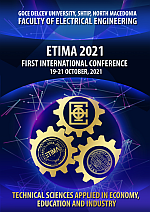NANOTECHNOLOGY–BASED BIOSENSORS IN DRUG DELIVERY SYSTEMS: A REVIEW
Abstract
Abstract
Going nano means not only the size of a matter will be reduced but also the matter can be manipulated on the
molecular and atomic levels. As a result, it will bring many benefits. In the case of a nanoparticle or a quantum
dot, for example, reducing the size will increase the surface activity and induce unique quantum effects (e.g.,
confinement of electrons or photons by controlling the densities of electron states or photon states). This in turn
will lead to unprecedented electronic, optical, and magnetic properties of the nanoparticle and quantum dot.
Furthermore, the ability to arrange and rearrange atoms and molecules at will in a material will help render
novel physical and chemical properties for the material. In today’s definition, biosensors are analytical devices
that combine a biological-sensitive element with a physical transducer to selectively and quantitatively detect the
presence of specific compounds in a given biological environment. The biological-sensitive element consists of
biological receptors (as probes) made of molecular species such as antibodies, enzymes, or nucleic acids for
binding the target analytes, and the physical transducer is for converting the biological recognition or binding
event into an electrical or optical signal. Thus, from a material’s viewpoint, today’s biosensors consist of two
major components: an organic part as the sensitive element and an inorganic part as the transducer element.
Many progresses have been made in the development of lab-on-a-chip microscale devices, and surely these
devices will become more compact and more functional with higher sensitivity, specificity, and reliability in terms
of sensing and with higher controllability in terms of drug delivery as the field of nanobiotechnology advances,
but full-fledged autonomous systems of biosensors for drug delivery applications may still be years away.
Currently, the development of biosensors for drug delivery takes a slightly different route. As discussed in the
Introduction, drug delivery systems have been evolving from the totally passive drug-carrying vehicles of the firstgeneration
systems, the environmental-sensitive drug-carrying vehicles of the second-generation system, to the
target-specific and bioactive drug-carrying vehicles of the third-generation systems. Following this route, one
can see that by adding sensitive components to the drug delivery systems, integrated capabilities of biosensing
and drug delivery can be realized. Thus, it is conceivable that the next-generation drug delivery systems could be
biologically sensitive drug-carrying vehicles incorporated with an underlying transducer (e.g., optical or image
based) for signal detection and communication. This route may eventually converge with the lab-on-a-chip route,
leading to an autonomous system with both the diagnostic and therapeutic functionalities. But for now, one of the
challenges in developing biosensitive drug delivery vehicles is to devise drug carriers that are biocompatible,
resistive to biodegradation, resistive to host inflammatory and immunologic responses, and sensitive to specific
targets, among other things. In addition, the drug carrier constructs should be highly effective in prolonged drug
retention, especially for water-soluble drugs. Biological constructs such as liposomes are potentially good drug
carrier materials due to their abilities to protect drugs from degradation and to target the specific site for action.
Key words: analytical devices,


